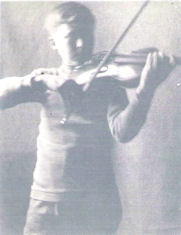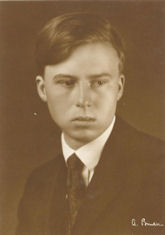|
|
Wolfgang Graeser (Composer, Arranger) |
|
Born: September 7, 1906 - Zürich, Switzerland
Died: June 13, 1928 - Nikolassee, Germany (suicide) |
|
The Swiss composer, Wolfgang Graeser, was born, of Swiss and German parents, in Zürich. He spent his childhood in Naples and Munich, and lived since 1921 in Berlin, where he attended the school until age 17. In Berlin he studied violin with Karl Klingler and quickly acquired erudition in theory. He studied at the University of Berlin, especially mathematics, physics, music, science, and oriental languages (Chinese, etc.) and there after 6 semesters of passed the doctorate exams successfully. He had an unusual artistic talent not only as a musician but also as a painter and in 1919, his paintings were displayed in Munich publicly. During the stormy years of the Weimar Republic, he spent in Berlin the most significant part of his short and tragic life.
Wolfgang Graeser is known to J.S. Bach scholars as the re-discoverer of Die Kunst der Fuge (BWV 1080). He was among the first to recognise it as a major, unified work of art rather than merely an academic tour-de force. In 1923 he discovered the structure of Die Kunst der Fuge, and during 1924-1925 he presented publicly his findings in various venues, such as at the Mw. Congress in Basle in 1924, and described in detail in the Bach year 1924. This is a re-order the 2nd Part, Contrapunctus Xllff, in comparison with the original edition of 1750, more specifically 1752, due to an initial conception of the work as an organic, unified composition with successive logically related parts. His critical study of Die Kunst der Fuge was recommended in 1926 by Professors J. Wolf and W. Altmann of Berlin as a Supplementary Volume to the BGA, because the BGA had already been completed in 1900. The re-discovery led in 1927 to its first public performance in its entirety, from Graeser's realisation and orchestration, 177 years after it appeared. The performance, by players from the Gewandhausorchester Leipzig, took place, fittingly, at J.S. Bach's own church Thomaskirche in Leipzig on June 26, 1927, under the direction of Karl Straube, the then holder of J.S. Bach's post of Thomaskantor.
After a second performance of Die Kunst der Fuge, Wolfgang Graeser published in Munich, "Körpersinn", "eine metaphisisch-psychlogischer Versuch" (Body sense, a psycho-metaphysic logical attempt.) Graeser left two other, larger and more comprehensive publications only as sketches: "Der späte Bach (1738-1750)" (The late Bach) and "Hörsinn, neue Bahnen in der Mf.", which gives a summary of the Beethoven Congress in Vienna in 1927.
Wolfgang Graeser had personal relationships with Oscar Spengler and with Albert Schweitzer. What is less well known is the many-sidedness of Graeser's genius and the conflicting influences brought to bear on it, which led to his suicide less than a year after that triumphant performance.
The life and achievement of Wolfgang Graeser show the fate of an early-matured person. The effect of the premiere of Die Kunst der Fuge in its reorganisation and orchestration, as well as its successive performance by the most important conductors was unexpectedly impressive and convincing. Reports by leading heads of musical life helped to spread its significant influence. The work came forward in circles of the music world in the subsequent period, and was further researched by critics as: Hans Theodor David, J. Handschin, H.G. Hoke, and the contemporary Christoph Wolff. Nevertheless, what Karl Straube wrote shortly after premiere: "The revival of Die Kunst der Fuge is his fame and made him immortal." |
|
Works (published) |
|
Kunst der Fuge von Joh. Seb. Bach im Bachjahr 1924, 1-104 und Taf. I-VI, sowie in Kgr-Ber.Basel 1924, 151-152 (Inh.): Krit.Na der Kusnt der Fuge als Suppl-Bd. (XLVII) der alten Bach-GA, Leipszig, 1926, XXXI, 130, Taf.n, Facs.; hierzu Stud-Partitur mit unterlegtem KI.A., Veröffentlichungerder NBG, Jg. XXXVIII, H.I, Leipzig, 1927
Chronik der Kunst der Fuge in Annalen 2, 1928, Horgen-Zürich/Leipzig, 66-68 u.a.a.O.
Körpersinn - Gymnastik/Tanz/Sport, München 1927 /2/1931); Neue Bahnen.in der Mf. In KGr-Ber. Beethoven-Zentenarfeier, Wien 1927, 301-303. |
|


|
|
Documents |
|
Source: Bakerís Biographical Dictionary of 20th Century Classical Musicians (1997); Find Articles Website (from Musical Times); Barbara Graeser (February 2009), English translation by Aryeh Oron (June 2009)
Contributed by Aryeh Oron (July 2007); Barbara Graeser (February 2009), |
|
Wolfgang Graeser : Short Biography | Documents | Piano Transcriptions: Works | Recordings | Other Arrangements/Arrangements: Works | Recordings |
|
Links to other Sites |
|
Wolfgang Graeser (1906-28): A forgotten genius Musical Times (Find Articles) |
Wolfgang Graeser (Wikipedia) [German] |
|
Bibliography |
|
H. Zurlinden : Wolfgang Graeser (Munich, 1935)
Hans Zurlinden: Wolfgang Graeser, München 1935 (Abdr. In "Letzte Ernte", Sbd. Von dems, Erlenbach-Zürich 1968.
Fast alle grösseren Arbeiten über die Kunst der Fuge seit 1927, insbesondere
F. Szymichowski: "Zu den Neuordnungen von Bachs Kunst der Fuge durch Wolfgang Graeser und Hans Theodor David" in ZfMw 12, 1930, 480-488
Stephen Tunnicliffe: "Wolfgang Graeser (1906-28): A forgotten genius" in Musical Times, Spring 2000. See link above. |
|
|